Papers by ANASTASIA KOSTAKI
It is generally known that the age-specific probabilities of dying exhibit a typical pattern comm... more It is generally known that the age-specific probabilities of dying exhibit a typical pattern common in all human populations. It is also extensively known that, in every population, males and females experience significantly different mortality levels. However the gap between the mortality patterns of the two sexes significantly varies through ages exhibiting a pattern that became typical since the middle of the 20th century. In this paper we present a parametric model for the description of this pattern, which presents the log ratio between the male and female empirical probabilities of dying as a parametric function of age. For evaluating the adequacy of the model proposed, we fit it to empirical data sets of a variety of populations and time periods. This model can serve as a tool for comparisons of the sex-differentiated mortality between populations and through time.
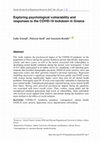
Vienna Yearbook of Population Research
This study explores the psychosocial impact of the COVID-19 pandemic on the population in Greece ... more This study explores the psychosocial impact of the COVID-19 pandemic on the population in Greece during the general lockdown period. Specifically, depression, anxiety and stress scores, as well as the factors associated with vulnerability to developing mental health conditions during this period, were investigated. A total of 911 adults participated in an online survey by completing a self-reporting questionnaire that included demographic questions, DASS-42 items (anxiety, stress and depression scales) and other questions related to personal experience. Regression modelling uncovered a significant relationship between gender and DASS scores, with women having significantly higher scores than men for all mental health problems. Participants aged 20–39 years were especially vulnerable to experiencing poor mental health. Unemployed participants reported having worse mental health than others. Having more perceived psychosocial support during the pandemic was associated with lower overa...

Journal of Refugee Studies, 2019
This study identifies factors that affect safety, health and trauma among refugees and asylum see... more This study identifies factors that affect safety, health and trauma among refugees and asylum seekers newly arrived and accommodated in Greece. The data of this study was collected from the REHEAL (Refugees’ Healing) project—a population-based survey conducted in six Greek refugee camps during the summer of 2016. We specified two binary logistic-regression models—one for safety and a second for health—as well as a multiple linear-regression model for the trauma score. Safety, health and trauma among refugees appear to be attributable to both pre- and post-displacement factors. The analysis shows that the mental and physical wellbeing of refugees and asylum seekers is strongly affected by post-displacement factors and, more specifically, by exposure to stressors in host countries, such as poor living conditions, limited access to health-care services and uncertainty about the future.

Communications in Statistics: Case Studies, Data Analysis and Applications, 2021
Abstract Greece is currently characterized by its low fertility levels and a postponement of chil... more Abstract Greece is currently characterized by its low fertility levels and a postponement of childbearing toward older ages. Greek Thrace, being a part of Greek territory since the second decade of the 20th century and the study area of this analysis, follows the same national trends, without forgetting the effects of local factors that cause some unique features in its fertility characteristics. Christian and Muslim populations inhabit this area; thus, a multicultural regime prevails. Besides that, Thrace’s ecological and environmental diversity, cultural and social variability, low socioeconomic development, high unemployment, and significant social and economic disparities affect the fertility decisions of the couples solely. This study explores the influence of several factors such as education, occupation, and religion on the fertility outcomes of the population by applying bivariate and multiple regression methods. The results confirm the complex nature of the couples’ fertility decisions under the agency of the cultural and socioeconomic environment. Such findings can outline policy guidelines in addressing population issues in this area. Additionally, they may serve in the interpretation of demographic phenomena of the whole country.
Communications in Statistics - Theory and Methods, 2017
This work examines the mortality characteristics of the population of Greece for the years 1961 t... more This work examines the mortality characteristics of the population of Greece for the years 1961 to 2014. The time period considered is of special interest for the modern demographic history of the country, since it is characterized by enormous developments on economic, political and social grounds. The life tables of the male and female population of Greece were constructed and several mortality indicators like life expectancy at chosen ages were calculated. For the purpose of analysis a statistical technique for smoothing the age-specific death rates in order to estimate the theoretical age-specific probabilities of dying was developed. This technique consists of a combination of the nine-parameter version of Heligman-Pollard formula proposed by Kostaki
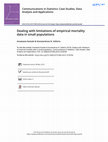
Communications in Statistics: Case Studies, Data Analysis and Applications, 2019
It is fairly well established that empirical age-specific mortality data are often characterized ... more It is fairly well established that empirical age-specific mortality data are often characterized by a number of limitations and deficiencies the most common of which is a pronounced tendency in age declaration to "round-off" to certain preferred digits. Another typical limitation of such data is that in many times they are only available aggregated in five-year age groups and/or they are incomplete. In addition to these problems, special limitations related to the efficiency and stability of the empirical death data also arise when these data refer to small populations. In such cases, the age-specific death rates are inefficient estimators of the corresponding death probabilities as a result of the highest impact of randomness. However, for many purposes in both demographic analysis and actuarial practice, there is a need for both reliable and analytical estimation of age-specific mortality patterns. This article provides a review of the typical problems and limitations affecting mortality data of small populations, discusses their consequences in estimating age-specific mortality patterns, and also proposes ways to deal with them. In that, a theoretically consistent though computationally simplest technique for minimizing random variations in age-specific death counts is proposed and demonstrated using empirical death counts of some chosen small populations.
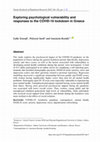
This study explores the psychosocial impact of the COVID-19 pandemic on the population in Greece ... more This study explores the psychosocial impact of the COVID-19 pandemic on the population in Greece during the general lockdown period. Specifically, depression, anxiety and stress scores, as well as the factors associated with vulnerability to developing mental health conditions during this period, were investigated. A total of 911 adults participated in an online survey by completing a self-reporting questionnaire that included demographic questions, DASS-42 items (anxiety, stress and depression scales) and other questions related to personal experience. Regression modelling uncovered a significant relationship between gender and DASS scores, with women having significantly higher scores than men for all mental health problems. Participants aged 20–39 years were especially vulnerable to experiencing poor mental health. Unemployed participants reported having worse mental health than others. Having more perceived psychosocial support during the pandemic was associated with lower overa...

ne of the most important developments in the Greek labour market over the last decade has been th... more ne of the most important developments in the Greek labour market over the last decade has been the increase in long-term unemployment as a percentage of overall unemplo y- ment : at least one of two unemployed has now been looking for work for more than a year. Although in the mid-eighties the percentage of long-term unemployment in Greece was signif i- cantly lower than the corresponding European Union average, by 1996 it had reached the level of 56%, against approximately 50% in the European Union (Figure 1). Although in 1985 the only countries in the EU having lower long-term unemployment than Greece were Denmark and Luxembourg, in 1996 there were only three EU countries: Belgium, Italy and Ireland, with higher levels of long-term unemploy- ment than Greece (European Com- mission, 1996). From the viewpoint of the aver- age length of time spent by the une m- ployed looking for work, Greece is also among the leaders in the Euro- pean Union. Only Ireland and Spain show higher figure...
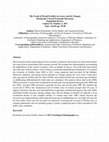
Population Review, 2017
Most research on the relationship between economic conditions and fertility has shown that fertil... more Most research on the relationship between economic conditions and fertility has shown that fertility has a procyclical relationship with economic growth. We examine this relationship by investigating the implications of the current economic crisis on fertility in Greece. Given the brief time period since the start of the economic crisis in Greece (a potential methodological limitation), we examine the evolution of fertility from 1960 to 2015, using empirical data provided by the Hellenic Statistical Authority and paying special attention to changes during the crisis years. Using these data, age-specific fertility rates by order of birth, total annual fertility rate, and mean age of mothers at childbearing differentiated by birth order are calculated. Our analysis shows that in the 2000s TFR increased as a result of the recuperation of births that were postponed during the late 1980s and the 1990s, and then TFR decreased, especially for first and second order TFR. We attribute the recent fall of TFR to the simultaneous fall of fertility rates of women younger than 30 years. It appears, therefore, that the crisis interrupted the recuperation of births that began in the early 2000s and halted fertility increases among younger ages. Recent changes in fertility are indicative of an accelerated decline of the complete fertility of women born after 1980, mainly because the recession was initiated during a time when the mean age of childbearing was very high (30 years for the first child). These facts do not allow for optimism concerning the reversal of fertility rates of younger generations who are probably going to spend a significant part of their reproductive life under crisis conditions.
<b>Copyright information:</b>Taken from "Status and perspectives of hospital mor... more <b>Copyright information:</b>Taken from "Status and perspectives of hospital mortality in a public urban Hellenic hospital, based on a five-year review"http://www.biomedcentral.com/1471-2458/8/28BMC Public Health 2008;8():28-28.Published online 23 Jan 2008PMCID:PMC2257958. n = 2368); II: Neoplasms (C00–D48, n = 1004); IV: Endocrine, nutritional and metabolic diseases (E00–E90, n = 419).
A topic of interest in demographic and biostatistical analysis as well as in actuarial practice, ... more A topic of interest in demographic and biostatistical analysis as well as in actuarial practice, is the graduation of the age-specific mortality pattern. A classical graduation technique is to fit parametric models. Recently, particular emphasis has been given to graduation using non-parametric techniques. Support Vector Machines (SVM) is an innovative methodology that could be utilized for mortality graduation purposes. This paper evaluates SVM techniques as tools for graduating mortality rates. We apply SVM to empirical death rates from a variety of populations and time periods. For comparison, we also apply standard graduation techniques to the same data.
Demographic Research a free, expedited, online journal of peer-reviewed research and commentary i... more Demographic Research a free, expedited, online journal of peer-reviewed research and commentary in the population sciences published by the
The Springer Series on Demographic Methods and Population Analysis
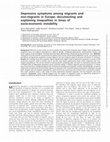
European Journal of Public Health
Background: With the current study, we aim to explore the extent that migrants report higher rate... more Background: With the current study, we aim to explore the extent that migrants report higher rates of depressive symptoms than non-migrant populations in light of gender, childhood experiences, socioeconomic factors and social support across European countries that have been differentially influenced by the economic crisis. Methods: Using data from the seventh round of the European Social Survey and the Greek MIGHEAL survey, we compare the prevalence of depressive symptoms among migrants and non-migrants aged 25-65 years old across 21 countries. Results: Our findings show that migrants report significantly higher levels of depressive symptoms in seven of the examined countries, while in Greece and in the UK, they report significantly lower levels compared with nonmigrant populations. The current climate of socioeconomic instability does not seem to necessarily associate with increased rates of depressive symptoms across countries neither it affects migrants and non-migrants in a similar way. Financial strain, childhood experiences of economic hardship and domestic conflict, female gender, as well as experiences of perceived discrimination appear to associate with increased levels of depressive symptoms among both migrant and non-migrant populations, while social trust and living with children have a protective impact. Still, much variation exists in the range of these associations between migrants and non-migrants and across countries. Conclusion: These findings suggest that the impact of migration status on depressive symptoms is subject to additional determinants of mental health as well as to contextual factors.
European Journal Of Public Health











Uploads
Papers by ANASTASIA KOSTAKI